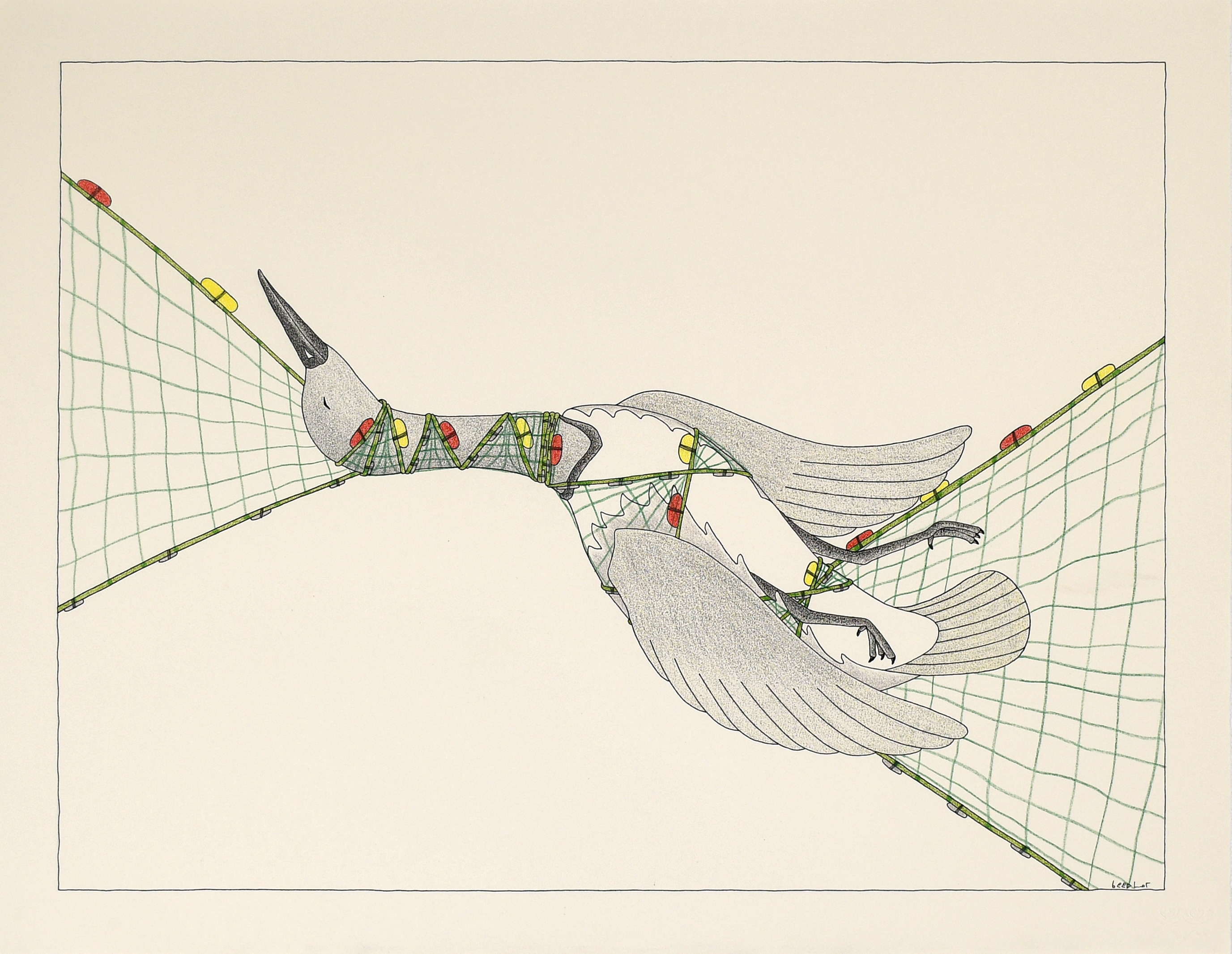Works by Nunavut, Canada artist Qavavau Manumie featured in Warsaw exhibition

A number of works by Canadian artist Qavavau Manumie are being featured in an exhibit at the Museum of Modern Art in Warsaw that explores environmental perspectives from around the world.
The Penumbral Age: Art in the time of Planetary Change launched this month with works from over 60 individual artists, artists teams and collectives.
The focus of the exhibition is presenting artistic reflections on the changing environment from over the last 50 years.
The name of the exhibition comes from the 2014 book The Collapse of Western Civilization: A View from the Future by Naomi Oreskes and Erik M. Conway. The book is written from the perspective of a historian in 2393, looking back at how the global population ignored scientific warnings about climate change in the “period of the penumbra” until civilization collapsed in 2093.
“Symbolism that we have never encountered before”
Besides works from artists like Pakistani sculptor Rasheed Araeen or the Polish neo-avant-garde artist Teresa Murak, drawings by Qavavau Manumie, who lives and works in Canada’s eastern Arctic territory of Nunavut, were also chosen for the exhibition.
They are the only Canadian works featured.
Besides being a well known artist, Manumie is also a printmaker at Kinngait Studios, known worldwide for its annual print collection.
A look at the art of printmaking as done by people like Qavavau Manumie (Kavavaow Mannomee), Pitseolak Niviaqsie and Niveaksie Quvianaqtuliaq in Kinngait, Nunavut:
In a conversation posted on the website of The West Baffin Eskimo Co-operative (WBEC), the Arctic Canadian business behind the renowned print program, the curators of the Warsaw exhibition told the co-op’s William Huffman that Manumie’s Arctic perspective on global climate change helped attract them to his work, which they first encountered though the Toronto Biennal contemporary visual art event.
“The place where the artist lives and creates is directly and radically experienced by climate change as a result of which the ice covers are melting and the natural cycle in which fauna and flora functions is disturbed,” said Sebastian Cichocki and Jagna Lewandowska.
“Organically, therefore, this theme permeates the artist’s art. In his works Manumie talks about everyday life, filtering it through the incredible imagination and symbolism that we have never encountered before.”

The importance of Indigenous artists on climate
Cichocki and Lewandowska also said the voices of Inuit artists are key to understanding the implications of the world’s changing ecology.
“Art of Indigenous artists has a special role to play here, as they are usually witnessing all those drastic climate changes firsthand and they can report on it, using visual languages,” they said.
“Looking at the many gorgeous examples of Inuit art, being more and more present in the realm of contemporary art, we can observe how it resonates globally and help us to re-imagine the relationship between species and envisioning the new, more symbiotic way of coexistence, with all the living creatures and matter on Earth.
For more on how Inuit artists from arctic Canada are tackling climate and social change in their work, watch Eilis Quinn’s 2010 documentary report filmed in Kinngait, Nunavut for Eye on the Arctic:
William Huffman, the WBEC marketing manager, says having Manumie’s work featured alongside such a diverse group of international artists, will also allow people to get new insights into the importance of the contemporary art coming out of Arctic Canada.
“To have Qavavau Manumie’s work alongside some of the heavy hitters of the contemporary art world allows you to see that work in a new way,” Huffman said in an telephone interview with Eye on the Arctic from Toronto.
“You start to perceive the nuances of the human condition within that, the scale of his human figures in relation to animals and landscape. And that’s when you really start to situate Qavavau Manumie within modern and contemporary art theory.”

Bringing Inuit art to eastern Europe
The exhibition opened on June 5 and Huffman said he’s already been contacted by approximately half a dozen people within the Warsaw art community about featuring Inuit art in other venues.
“We consider Poland as our gateway into eastern Europe and further opportunities to feature the incredible contemporary art and artists coming out of Cape Dorset,” he said.
The Penumbral Age: Art in the time of Planetary Change runs until September 13.
Write to Eilís Quinn at eilis.quinn(at)cbc.ca
Related stories from around the North:
Canada: Inuit artists in their own words, Eye on the Arctic
Finland: Sámi-themed Finnish short film makes Sundance lineup, Yle News
Greenland: `Enough of this postcolonial sh#%’ – An interview with Greenlandic author Niviaq Korneliussen, Eye on the Arctic
Iceland: Icelandic artist Olafur Eliasson lights up London’s Tate Modern, Blog by Mia bennett
Norway: Walt Disney Animation Studios to release Saami-language version of “Frozen 2”, Eye on the Arctic
Russia: Russia’s Arctic culture heritage sites get protection, The Independent Barents Observer
Sweden: Sweden, Norway team up to preserve ancient rock carvings, Radio Sweden
United States: Set of Indigenous Yup’ik masks reunited in Alaska after more than a century, CBC News



